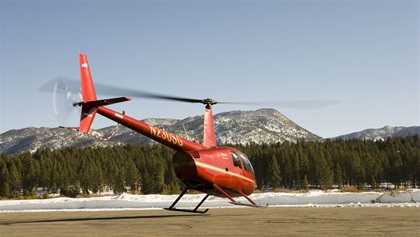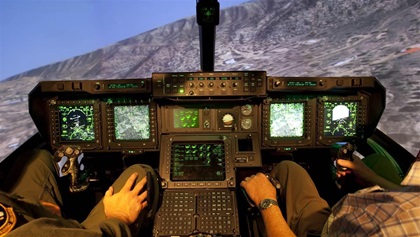It’s all about the power
Training to fly helicopters in the mountains
The images are breathtaking. A Boeing Chinook sits only on its rear wheels on a small rock outcropping while soldiers pile out the open back door. A climber hangs onto a small piece of rock as one wheel of a Sikorsky Black Hawk plants down and he’s pulled inside.

 These daring feats are impressive enough on their own, but when you consider that they happen at thousands of feet of density altitude in an unpredictable mountain environment, they take on even more meaning, especially to pilots who understand just how difficult that type of flying can be.
These daring feats are impressive enough on their own, but when you consider that they happen at thousands of feet of density altitude in an unpredictable mountain environment, they take on even more meaning, especially to pilots who understand just how difficult that type of flying can be.
Most helicopter pilots receive little practical guidance on mountain flying. They are taught run-on takeoffs and landings for when the machine can’t muster enough power to hover. Book learning matches that of fixed-wing pilots, but that’s pretty much the extent of it. Yet the versatility of helicopters means that pilots are often called upon to perform many tasks in the mountains that would be difficult or impossible via any other means.
Many of these are rescues conducted by military pilots and crews. These professionals are also some of the same people who were called upon to fight in the mountains of Afghanistan, many without formal mountain flying training.
 To address a lack of mountain flying qualifications and experience among its crews, 30 years ago the Army established the High-Altitude Army National Guard Aviation Training Site in Gypsum, Colorado. Here pilots from the Army, other service branches, and foreign countries come to train in the theory and practice of high-altitude operations. Normally the training lasts a week, with the first day spent in the classroom and the remainder in a helicopter.
To address a lack of mountain flying qualifications and experience among its crews, 30 years ago the Army established the High-Altitude Army National Guard Aviation Training Site in Gypsum, Colorado. Here pilots from the Army, other service branches, and foreign countries come to train in the theory and practice of high-altitude operations. Normally the training lasts a week, with the first day spent in the classroom and the remainder in a helicopter.
The training revolves around the concept of power required versus power available. Pilots are taught not to take chances and guess whether or not they will have adequate performance. They focus first on the altitude, location, topography, and weather of the landing zone (LZ), and then determine if they have enough power available for the mission, and how much margin may be left over. That’s the first step in determining whether a particular LZ is usable. The site may require 65 percent of the helicopter’s power, for example, but the altitude has reduced engine power to a maximum of only 75 percent.
On the way to the site the pilots are trained to look at the current conditions and see if they match the expectations. Warmer or colder temperatures than forecast obviously impact the power available and power required. Changes in wind have an impact as well.
 Once near the LZ, HAATS uses a seven-step checklist to evaluate the conditions and determine whether the approach and landing can be completed safely. The items are identifying the LZ; evaluating performance considerations; wind and terrain analysis, determining the routes in and out, and identifying a fly-away route prior to the approach decision point; and then completing a low reconnaissance pass, approach, and takeoff.
Once near the LZ, HAATS uses a seven-step checklist to evaluate the conditions and determine whether the approach and landing can be completed safely. The items are identifying the LZ; evaluating performance considerations; wind and terrain analysis, determining the routes in and out, and identifying a fly-away route prior to the approach decision point; and then completing a low reconnaissance pass, approach, and takeoff.
Hyperlocal conditions are probably the most challenging part of the flight, according to U.S. Army Chief Warrant Officer 5 David Gates, a senior instructor at HAATS. “You have to run through scenarios that will require more power,” he said. This includes things like downsloping terrain, turbulent air, tailwind, and more.
“All this flows into an approach decision,” he said. Not unlike the stabilized approach concept in fixed-wing, by the time the pilot reaches the approach decision point he or she must make sure certain parameters are met. “That point can be anywhere, as long as it’s far enough away and at a sufficient altitude that the pilot can perform a fly-away.”
 Gates doesn’t like the term “escape route” because it comes with the implication of an emergency, and is thus reactive. Instead, the fly-away is a go-around point, unlike the committed point after which an abort might not be possible. Because helicopters require increasing power as they slow down toward a hover, there have been many accidents where the pilot tried to bring the aircraft in for a landing on a high mountain LZ only to find there was no more power left to give. That results in a hard landing, or drooping the rotor system.
Gates doesn’t like the term “escape route” because it comes with the implication of an emergency, and is thus reactive. Instead, the fly-away is a go-around point, unlike the committed point after which an abort might not be possible. Because helicopters require increasing power as they slow down toward a hover, there have been many accidents where the pilot tried to bring the aircraft in for a landing on a high mountain LZ only to find there was no more power left to give. That results in a hard landing, or drooping the rotor system.
At HAATS they look for the right attitude, a descent rate of less than 300 feet per minute, the right ground spped and rate of closure, and approximately 10 percent below hover in ground effect torque once the helicopter reaches about 40 knots. Then, if the conditions are met, the approach can continue. “It all comes down to the situational awareness triangle and the relationship between the aircraft, the environment, and the pilot,” Gates said.
Although the meteorology and physics involved in mountain flying are the same for airplane and helicopter pilots, the unique power requirements and missions that helicopters perform in the mountains make specialized training even more important.
https://co.ng.mil/About/Schoolhouse-HAATS/



